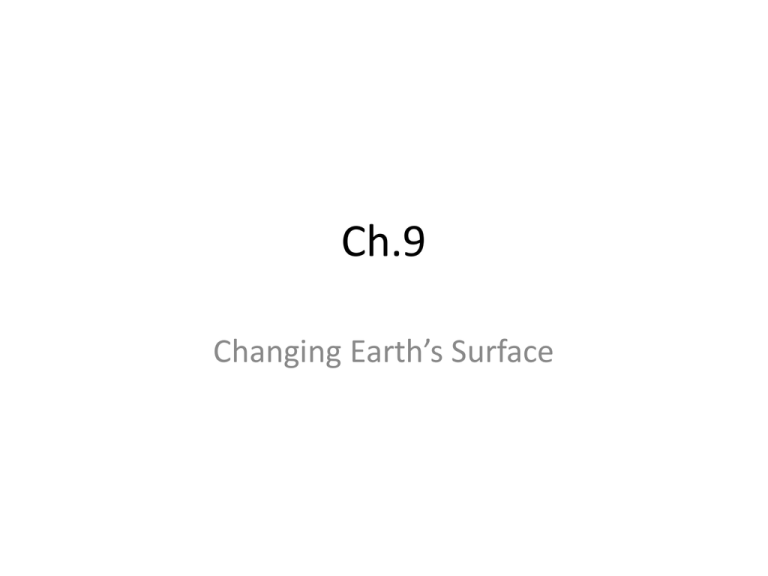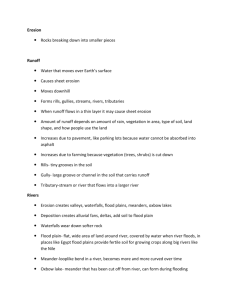Ch.9 - Stephanie Dietterle Webpage
advertisement

Ch.9 Changing Earth’s Surface Section 2: Water Erosion • Runoff and Erosion – Moving water is the major agent of the erosion that has shaped Earth’s land surface – Runoff is water that moves over Earth’s surface – When runoff flows in a thin layer over the land, it may cause a type of erosion called sheet erosion Section 2: Water Erosion • Runoff and Erosion – Amount of Runoff • Depends on five main factors – 1st: amount of rain an area receives – 2nd: vegetation (grasses, shrubs, and trees reduce runoff by absorbing water and holding soil in place) – 3rd: type of soil (some types of soils absorb more water than others) – 4th: shape of the land – 5th: how people use the land Section 2: Water Erosion • Runoff and Erosion – Rills and Gullies • As runoff travels, it forms tiny grooves in the soil called rills • A gully is a large groove, or channel, in the soil that carries runoff after a rainstorm – Streams and Rivers • A stream is a channel along which water is continually flowing down a slope • Streams rarely dry up • Small streams are also called creeks or brooks Section 2: Water Erosion • Runoff and Erosion – Tributaries • A stream grows into a larger stream or river by receiving water from tributaries • A tributary is a stream or river that flows into a larger river • Example: the Missouri and Ohio rivers are tributaries of the Mississippi River Section 2: Water Erosion • Erosion by Rivers – Through erosion, a river creates valleys, waterfalls, flood plains, meanders, and oxbow lakes – Waterfalls • They occur where a river meets an area of rock that is very hard and erodes slowly • The river flows over this rock and then flows over softer rock downstream • Eventually a waterfall develops where the softer rock was removed • Areas of rough water called rapids also occur where a river tumbles over hard rock Section 2: Water Erosion • Erosion by Rivers – Flood Plains • The river spreads out and erodes the land, forming a wide river valley • The flat, wide area of land along a river is a flood plain • A river often covers its flood plain when it overflows its banks during a flood – Meanders • Is a loop-like bend in the course of a river • As the river winds from side to side, it tends to erode the outer bank and deposit sediment on the inner bank of a bend Section 2: Water Erosion • Erosion by Rivers – Oxbow Lakes • is a meander that has been cut off from the river • May form when a river floods • During the flood, high water finds a straighter route downstream • As the flood waters fall, sediments dam up the ends of a meander • The meander has become an oxbow lake Section 2: Water Erosion • Deposits by Rivers – Deposition creates landforms such as alluvial fans and deltas. It can also add soil to a river’s flood plain. – Alluvial Fans • Where a stream flows out of a steep, narrow mountain valley, the stream suddenly becomes wider and shallower; the water slows down • An alluvial fan is a wide, sloping deposit of sediment formed where a stream leaves a mountain range Section 2: Water Erosion • Deposits by Rivers – Deltas • A river ends its journey when it flows into a still body of water, such as an ocean or lake • The sediment in the water drops to the bottom • Sediment deposited where a river flows into a ocean or lake builds up a landform called a delta – Soil on Flood Plains • Deposition can also occur during floods • Then heavy rains or melting snow cause a river to rise above its banks and spread out over its flood plain • When the flood water finally retreats, it deposits sediment as new soil Section 2: Water Erosion • Groundwater Erosion – When rainfall/snow melts occur not all the water evaporates, some water soak into the ground – There it fills the openings in the soil and trickles into cracks and spaces in layers of rock (groundwater) – Groundwater can cause erosion through a process of chemical weathering Section 2: Water Erosion • Groundwater Erosion – Cave Formations • A deposit that hangs like an icicle from the roof of a cave is known as a stalactite • Slow dripping builds up a cone-shaped stalagmite from the cave floor • The action of carbonic acid on limestone can also result in deposition – Karst Topography • If the roof of a cave collapses because of the erosion of the underlying limestone, the result is a depression called a sinkwhole – this type of landscape is called karst topography • This type of landscape is found in Florida, and Texas





